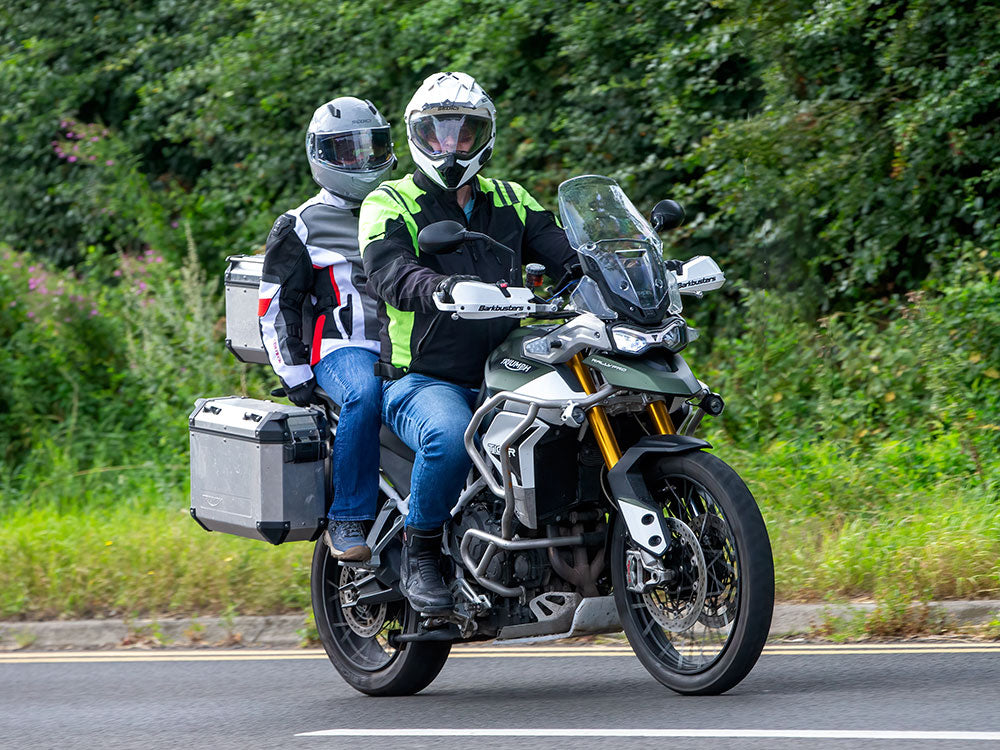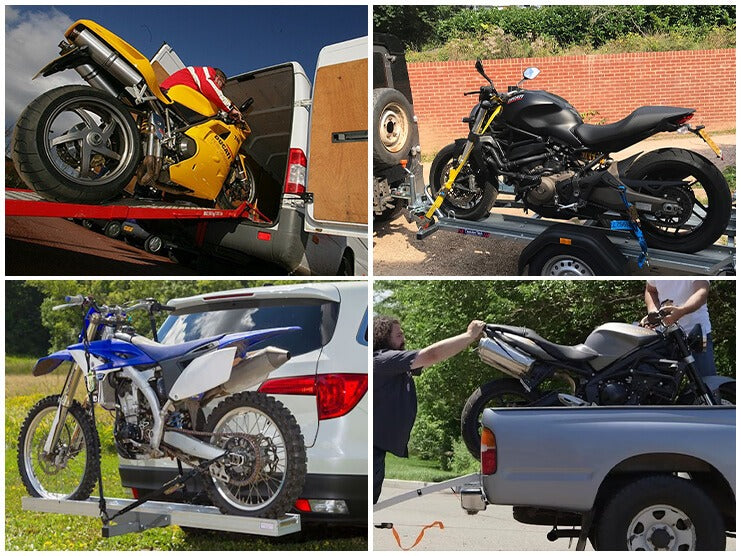Table of Content
Riding with a passenger can feel different than riding alone. If you wish to ride on the back of a motorcycle as a passenger, you would want a rider with experience operating motorcycles and transporting passengers.
Learning to ride a motorcycle is hard, but riding with a passenger is even harder. Though some rider training courses provide some advice on how to ride with a passenger, other riders are the only people you can ask for advice.
Experienced motorcyclists should make sure that their passengers are wearing protective equipment, how to sit and dismount, how to lean when turning corners, how to brace when braking, and how to communicate. Since the passenger’s safety is in the hands of the rider, the rider must make sure the passenger knows how to behave on the road.
When riding with a passenger, you will have to be careful maintaining balance and control due to the passenger adding extra weight to the two-wheeler’s rear end.
Only travel with a passenger if you are confident and comfortable doing so regardless of the nature of your trip.
1. How to Maintain Your Motorcycle Before Riding
1.1 Clean Motorcycle

Clean your motorcycle’s exterior with a clean cloth and scrub out any stubborn stains with soap and water. As you clean your bike, you might find signs of damage inside the parts of the motorcycle and quickly repair them before your next ride.
Especially during the winter and after riding in the rain, dry off any moisture on the metallic parts to prevent rusting. Also, clean your brake discs by wiping off any grease, spray, or debris caked.
During the winter, make sure to also look inside the exhaust and airbox to ensure that no mice or other tiny creatures have made a home inside. Cleaning out the airbox and exhaust pipes will keep them from clogging and ensure clean filtered air flows.
1.2 Do a Close Inspection
- Tighten any loose bolts
- Inspect the wheels and brake pads
- Check for any exposed wiring
- Lubricate the throttle and clutch cables
- Make sure the wheels spin without resistance
- Make sure the handlebars turn without obstruction.
- Inspect the forks and fork seals for any leaks
1.3 Check the Oil and Fluid Levels

Change out older oil to ensure the engine is properly lubricated, does not overheat, and lasts longer. You should also change out other older fluids such as brake fluid and coolant.
1.4 Check the Battery, Cable, and Electrical System

Riders should ensure the battery has enough charge before going on a trip. It is best to charge your battery back to full even if you are only going to cover a few miles to avoid being stranded on the side of the road.
When checking the components powered by electricity, check and replace any blown fuses, and make sure all lights and gauges are working properly.
If you're planning to add additional lighting, this could help improve visibility when traveling during the winter or at night.
1.5 Check the Wheels and Tires
When inspecting the wheels and tires, run your fingers along the rims to make sure there are no cracks or dents. For spoked wheels, check and tighten any loose spokes, and replace any missing valve caps. Also, remove any rust if found. Rotate the wheels slowly to check for any cracks or wear and tear. If you park the motorcycle on a stand or jack, check the tire pressure and refill the tires if necessary. If your tires are old and worn, it is best to get replacements as soon as possible.

Tire Pressure
What is the correct air pressure for motorcycle tires? Depending on the type of tire, the air pressure may vary.
It is usually best to go with the value provided by motorcycle manufacturers. Motorcycles may have labels indicating adequate tire pressures for cargo and road conditions. For heavier cargo, the manufacturer recommends filling their tires with slightly more pressure than the minimum limit.
For example, big fat tires on ATVs and UTVs often require low pressure, being fully inflated with as little as 2-10 psi. At the other end of the spectrum, small trailer tires may require up to 60 psi. Street bikes, their tires typically range from 28 to 40 psi.
Effect of Temperature on Tires
The space within deflated tires can quickly increase in temperature, causing the tire walls to become heated. Worn tire walls, high temperatures, carrying heavy loads, and traveling at high speeds can result in the tires collapsing.
1.6 Check the Chain and Sprocket

If your motorcycle runs on a chain drive, then check the sprockets and chain.
Check the front sprocket seals for any oil leakage, while seeing if the chain is taut so that it will not suddenly break or come loose.
1.7 Install a GPS

One of the biggest advantages of a motorcycle GPS tracker is that you can quickly locate and recover your stolen bike quickly. Motorcycle thieves usually hide stolen bikes in storage rooms, vans, or industrial areas, but they are nearly impossible to find using conventional means. With an active GPS tracker, the tracker will send your bike’s location in real-time, so the police can find your stolen motorcycle quickly. As long as the tracker's battery lasts, it will transmit your bike's location.
A GPS can also provide directions and help navigate you to your destination.
2. Tips Before Traveling with a Passenger
- Do not exceed your motorcycle’s maximum weight limit; take the weight of your passenger, equipment, and luggage into account.
- Make sure your motorcycle’s brakes are in good working condition, function correctly, and can quickly stop even when carrying a heavy load.
- Refer to the motorcycle owner's manual for technical information.
- Check the tire pressure and use a tire pump to refill them if necessary.
- Adjust the rear suspension to compensate for the compression dive.
- Adjust the rear shock absorber and the height of the headlight to compensate for additional weight, leaning angles, and bumpy road conditions.
- Practice in an area with less traffic before taking a passenger with you on busy city streets and highways.
2.1 Required Motorcycle Riding Gear
Proper Apparel
When riding a motorcycle, you and your passenger need to protect yourselves in case of an accident. Wearing proper motorcycle apparel can help reduce the risk of injury.
Helmet
Motorcycle helmets help protect against serious head injuries and trauma due to collisions. The helmet you choose should have a strong chin strap, a durable shell, and a visor with no cracks in the surface or any fragile pads.
Riders should make sure their passengers have brightly colored helmets with reflective surfaces that perfectly fit their heads.
Safety Glasses
To protect your eyes from the wind, dust, rain, insects, and small pebbles, safety glasses or face shields to ensure you have clear vision.
When wearing safety glasses, make sure they are scratch free, made of non-shattering material, and provide a clear view. Do not wear a shaded pair of safety goggles or face shields at night since it will make it harder to see.
Protective Clothing
i) Jackets and Pants
Wearing a thick jacket and long pants will help cover the arms and legs. Motorcycle jackets will also keep you and your passenger warm when riding in cold or rainy weather. The jacket and pants should fit tightly so no loose fabric flutters in the wind.
ii) Boots or Shoes
Motorcyclists and passengers must wear boots that reach up to the ankles, have rugged and durable soles, and protect the feet. Don't wear shoes with long and loose laces as they can get caught in machinery.
iii) Gloves
Gloves ensure good grip strength when holding the handlebars. Long-cuff gloves provide the best protection for your fingers, knuckles, and wrists in the event of an accident.
Managing Weight Distribution
The passenger’s weight will affect your motorcycle’s performance, handling, braking, suspension, and acceleration.
Communication
When traveling on a motorcycle, the rider must be able to convey instructions to the passenger. Before starting the motorcycle, both parties should discuss the best way to communicate with each other. Before starting the motorcycle, you should ensure your passenger knows when you will start, stop, or turn the bike.
Instruct your passengers to sit up straight while you ride as slight movements can throw the motorcycle off balance, especially when turning corners.
Grip
The passengers should not wrap their arms around your waist while riding. Instead, make sure some adequate handholds and footrests will keep the passenger from falling backward or slamming against you when accelerating and braking.













Leave a comment
All comments are moderated before being published.
This site is protected by hCaptcha and the hCaptcha Privacy Policy and Terms of Service apply.